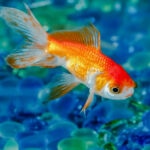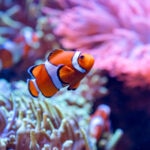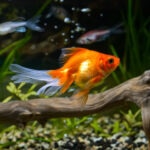Bushy Nose Pleco (Bristlenose Catfish) Characteristics

Photo by Chewy
Catfish are one of the most numerous groups of fish and one of the most popular with hobbyists. Even those who only have a single community tank likely have at least a couple of catfish. One of the most popular groups of catfish consists of the so-called plecos, the Loricaridae or suckermouth catfish. The bushy nose plecos are members of the genus Ancistrus, one of the most popular genera in this family.
Bushy nose plecos get their common name from the growths that develop on the heads of mature males. These growths make the males look like they are wearing a beard. For many years, these growths were used to differentiate many species; but then it was discovered that individual males would have more or less bristles at different times of the year. The exact mechanism for this is still not completely understood, but many experts believe it is associated with reproduction. In the aquarium, most Ancistrus species that have been spawned to date will spawn year round; so, many males retain their full regalia throughout the year.
No one is exactly sure how many species are in the genus Ancistrus, and even experts have trouble differentiating the species. So most aquarists just stick with the safe name “Ancistrus sp.” when describing the fish that they are keeping.
In general, Ancistrus are mottled with dark and light browns, sometimes with grays and blacks. Many, especially when young, have white or gold spots. These often fade as they reach maturity. Some have a white, blue or gold band on the edge of the caudal fin. This also usually fades with maturity.
Over the years, aquarists have developed several aquarium strains. Even with these, it is not clear which species we are working with. There is a beautiful albino strain, as well as a couple of different long-finned strains, which have also been bred into albino strains. The long-finned fish are especially striking, as the dorsal, pectoral and caudal fins can be nearly as large as the body in some full-grown males.
Many species are covered with various spines and hooks, and the male’s pectoral fins have a first ray covered with tiny little hooks almost like Velcro. In addition, they have a set of cheek spines that remind one of a combination of a switchblade knife and a medieval war mace. These cheek spines are kept tucked away until the Ancistrus feels threatened. Then they are extended instantly, almost like the fish flicking out a switchblade. He then thrashes from side-to-side, brandishing these formidable weapons. The problem for hobbyists is that the fish can’t tell the difference between the hostile intent of an enemy and the benign intent of the aquarist and a net. This leads to a tendency to become hopelessly entangled in the mesh of nets to the point where they have to be cut free. It is best to catch and move Ancistrus by using a plastic container to corner and lift them.
They have sucker mouths, which are lined with spoon-, peg- or comb-shaped teeth. With these, they rasp algae from surfaces in the wild and in aquaria. They are excellent algae-eaters and will quickly denude a tank of algae; at such a point, they need to be moved to another tank with algae or be given supplemental vegetarian fish food, or they will likely starve.
In aquaria, besides algae they will feed on algae wafers, algae-based flakes and pellets, zucchini, spinach, kale, romaine lettuce, peas, carrots and green beans. A particular favorite for some reason is canned French-cut green beans. Even wild-caught Ancistrus will eat them right away.
There is also some evidence that at least some species require wood in their diet. It’s a good idea to add a piece of driftwood for them to nibble upon. You will notice over time that it will shrink in size.
Mature male bushy nose plecos will fight with one another to establish territories, especially at breeding time. It is best to keep only one male to a tank or keep groups with several males in large tanks. Females are much more laid-back, and several can be kept together even in a 10-gallon tank.
Ancistrus are perfect for algae control in community tanks. They will scour every surface in the tank and soon develop a daily routine, visiting certain favorite spots every day. They will eat most types of green algae but ignore the red “beard” algae that plague so many aquaria (the person who discovers a fish that will eat these nasty algae will go down in aquarium history). They also seem to avoid the hair-type algae, though they will eat it if there is no other green food available. In general, they ignore plants, but some aquarists have blamed their bushy nose plecos for holes that appear in plant leaves. Whether this is due to the bushy nose or some other fish is still hotly debated. Personally, I have never had a bushy nose eat anything but algae and veggies.
Many aquarists breed bushy nose plecos, and it is likely that most available for sale in local pet shops are raised locally. The spawning setup is simple, and well-fed, mature bushy nose plecos are happy to cooperate year-round.
A 10-gallon tank makes a perfect love nest. The water should be kept in the range of 78 degrees Fahrenheit to no more than 82 degrees. The pH and hardness appear unimportant, but it would likely be best to use water around neutral with a low to moderate total hardness maybe no more than 250 ppm. A mature sponge filter with a gentle flow of bubbles, a piece of driftwood and several caves would complete the tank. Plants aren’t necessary, and ambient room light is adequate.
Add a pair or a trio of bushy noses. Feed daily with an assortment of vegetable foods, and give the tank regular 50-percent water changes. Add a single feeding of frozen brine shrimp, Mysis shrimp, bloodworms or other meaty foods every other day. This will help bring the females into spawning condition more quickly.
After a couple weeks of the royal treatment, the male will begin courting the females. He does this by swimming headfirst into a cave, then fanning and flashing his tail like a semaphore flag outside the cave entrance. He likely also releases some pheromones that this fanning movement helps to spread into the current. Ripe females will come over to investigate. He will allow a single female to enter the cave. She will lay a clump of maybe 75 to 100 orange to yellowish eggs, and he will fertilize them. It is surprising how large these egg clumps are: sometimes half the size of the female that lays them. These sticky egg masses look like clumps of orange grapes and will stay together even in a strong current.
The male will violently drive any interlopers away, and it would be best to remove the females at this point, though some hobbyists report the female will occasionally be allowed to “inspect” the egg clump. The male is on guard duty now until the eggs hatch. He gently rolls the egg clump and fans it with his fins to keep it clean and make sure it is well-oxygenated.
Sometimes the male will not care for the eggs at all, and the aquarist has to step in. It is best to remove the fish from the tank and move the egg mass up into a net breeder, where the eggs will have circulation all the way around. Some hobbyists move the filter so that the flow of water will be just near (but not directly on) the eggs.
Either way, after about four to five days, the eggs hatch. The larvae look like eggs with a tail at one end, a pair of eyes and a tiny sucker mouth. At this point, they are bright orange. Over the next few days, they will wiggle together and absorb their yolk sacs, slowly becoming darker. After about a week, they will have absorbed the yolk sac and will then need to be fed.
They are ravenous eaters and need to be fed several times a day. Foods like canned French-cut green beans, algae wafers and the algae on rocks are all devoured. Some hobbyists also feed some meaty foods, such as baby brine shrimp or microworms, but others stick to the veggies.
The fry grow quickly, and by four weeks they are an inch long and are miniature copies of their parents. At this point, it is best to spread them out into a couple of tanks where they can continue their rapid growth. Local pet shops will take the fry even at this small size, as there is always a demand for them.
If you reach this point, congratulations! You’ve completed another successful Adventure in Fish Breeding!
By: Chewy Editorial
Featured Image: Via Gary Lange



